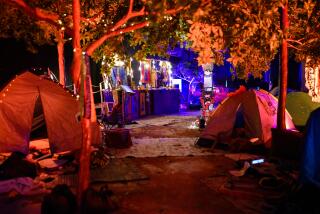Teaching Tolerance at the Holocaust Museum
- Share via
“Have you ever been punished for something you didn’t do?” the boy asks. “We were.”
So begins “Remember the Children: Daniel’s Story,” the powerful exhibit at the U.S. Holocaust Memorial Museum in Washington, D.C. It’s designed to help older children begin to understand this horrible chapter in history through the eyes of a Jewish boy growing up in Nazi Germany.
“We want kids to think about how it all started: name calling, excluding people, stereotyping,” said Warren Marcus, who coordinates school and adult programs for the museum.
We think about that as we walk through the rooms of Daniel’s life, reading passages from his diary as the Nazis grow increasingly powerful, and he and his family are forced to move from their comfortable Frankfurt home to a ghetto and, finally, to a concentration camp.
At first, we stand in his bedroom, surrounded by his clothes and schoolbooks, imagining his happy world. But soon, Daniel tells us, he can’t swim or play soccer, and he and his younger sister are forced to leave their school. His father, a hardware store owner, is not allowed to sell to non-Jews.
We touch the suitcase Daniel’s mother has hurriedly packed for his sister when they are told they must leave. And we walk into the small, bare room that Daniel’s family has been assigned in the ghetto.
Daniel wasn’t a real boy, although stories like his were certainly documented across Europe between 1933 and 1945.
The point here, museum officials stress, is not to frighten children. “This provides context for them. Personalizing history is important to young people,” said Shari Rosenstein Werb, the museum educator who coordinates the museum programs for elementary and middle-school students. About 400,000 youngsters visit each year with their schools. (Museum officials recommend that children be at least 8 to visit Daniel’s Story and 11 to see the rest of the museum.)
Why bring children at all? To teach them where intolerance and ignorance can lead. “We hope they will look at the world differently and see how they can make a difference,” Werb said.
My 12-year-old son and 10-year-old daughter were visibly moved as we traveled with Daniel and his father on their journey to the concentration camp, seeing the bare bunks where they slept and the striped pajamas they were forced to wear. We were relieved but saddened by the ending: Daniel and his father survived, though his sister and mother died. More than 1.5 million children were killed during the Holocaust, we’re told. Many lost their entire families.
At the end of the exhibit, the children are given the opportunity to write their thoughts on paper, drawing pictures. “How can people be so cruel?” one child asked. “I am proud that my grandfather fought to liberate the Jews,” said another.
My children, Matt and Reggie, spent a long time standing at the Wall of Remembrance, where more than 3,000 tiles are mounted as a memorial to the children who were murdered in the Holocaust. American youngsters created the tiles after seeing Daniel’s Story when it traveled to museums around the country, before the opening of the Holocaust Museum.
Afterward, we ventured upstairs to the stark, 36,000-square-foot Permanent Exhibition, even though I was conscious that Reggie and even Matt might find it painful. We skipped some of the most disturbing images and, instead, spent time reading some of the stories of resistance and rescue, especially those of ordinary people--taxi drivers, teachers, nurses and students--who hid their neighbors or smuggled children to safety. We listened to survivors’ videotaped testimony. Reggie was more comfortable thinking about those who helped others survive, rather than those who died. And she spent considerable time in the excellent Wexner Learning Center, an interactive computer center, to learn more about them.
Timed tickets are required to visit the Museum’s Permanent Exhibition and are distributed at the museum each day starting at 10 a.m. Reservations may be made through ProTix by calling [800] 400-9373. There is a $1.75 handling fee per ticket, plus a $1 charge per order. No passes are required to visit Daniel’s Story or the Wexner Learning Resource Center.
A special exhibit, “The Nazi Olympics,” opened Friday, to coincide with the opening ceremonies of the Atlanta Games, and will remain open through spring 1997. It discusses the political controversy surrounding the 1936 Berlin Games. (Call the museum at [202] 488-0400 for more information.)
Visiting the Holocaust Museum with children is not easy. It is emotionally draining and raises questions that aren’t easily answered. But I’m glad we went. “We need to talk to children about why this happened and how we can create safeguards so that it won’t happen again,” said Gerald Margolis, director of the Museum of Tolerance in Los Angeles.
That’s why the museum, which opened in 1993 in Los Angeles just a few months before the Holocaust Museum, offers special Sunday storytelling and theater programs for children. (Call the museum at [310] 553-9036 for details.) Children and adults are encouraged to confront bigotry in their own lives through exhibits on the Holocaust, the Los Angeles riots, hate groups and the struggle for civil rights.
“We’ve got to reach out to families and teach tolerance at a young age,” Margolis said. “Search out the positives. Show the kids that people can do the right thing.”
Taking the Kids appears the first and third week of every month.


